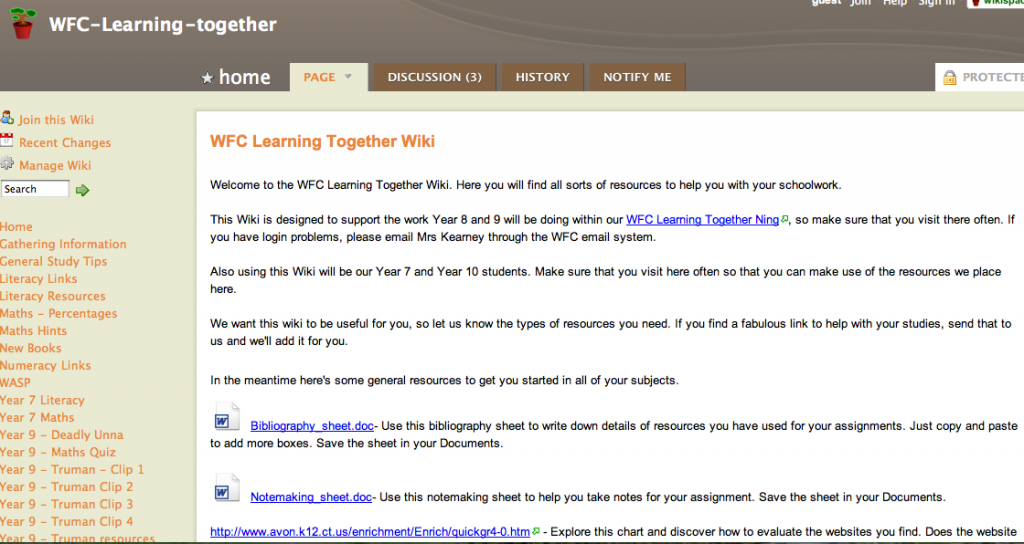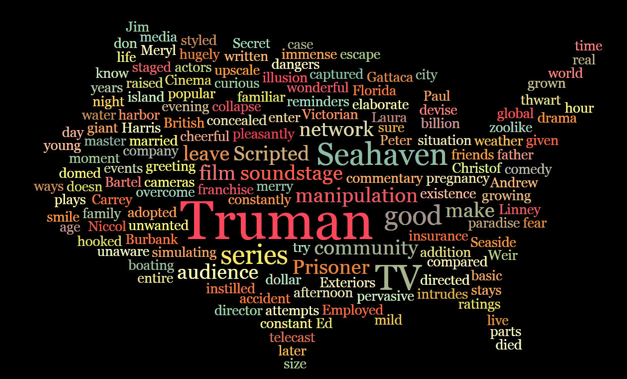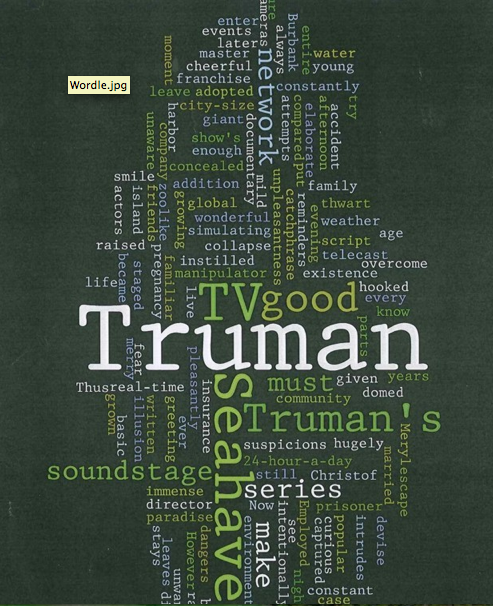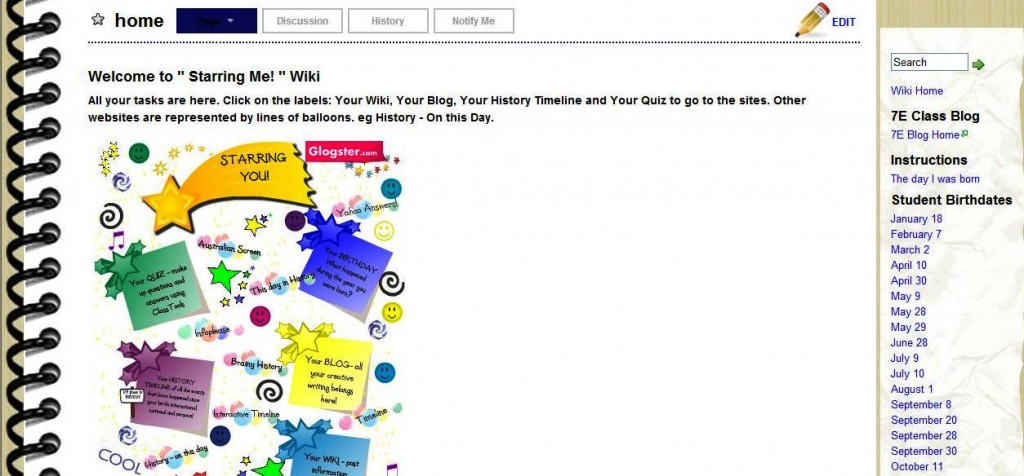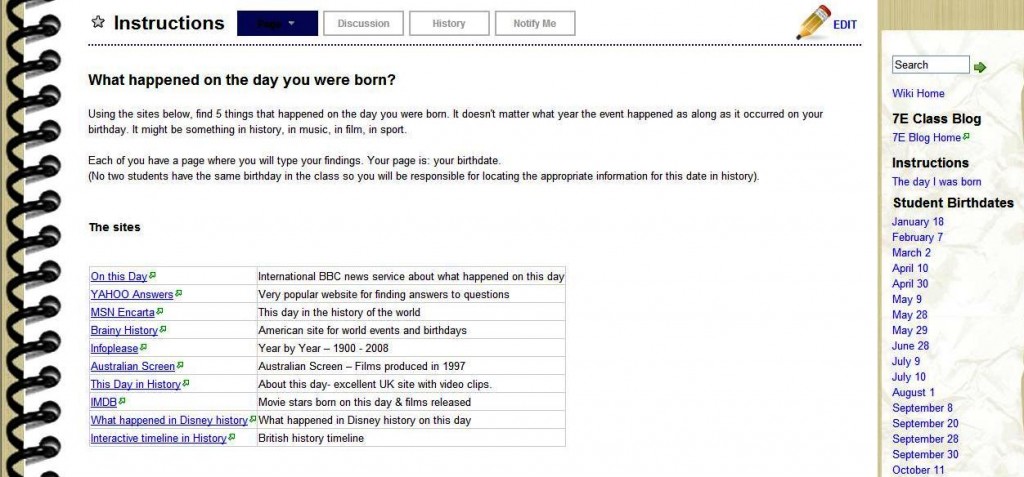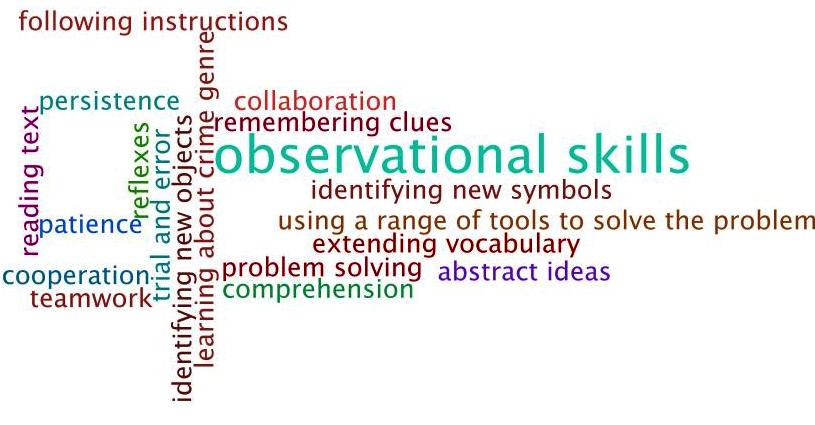I work very closely with the Learning Support team at my school and we are always looking for ways to present material to our students that is engaging and motivating. We began using a Ning with our Year 8 and 9 students this year, and decided to have a supporting Wiki, originally for our Year 7 boys. With Ning moving to pay only, I decided to trial how discussions would work on our Wiki and the following activity was developed.I wanted some graphics to add to our Truman Show section and created word clouds using Wordle and Tagxedo. I used two different summaries of the film as the text to create these graphics. Both were saved as .jpegs and uploaded to our Learning Together Wiki.Although most students had not begun discussing the film in their English class, we explored the two word clouds together. I explained how they had been created, and that the larger the word in the graphic, the more it appeared in the text that I had placed into the text box. Therefore those larger words would probably be more important.We began by comparing the two graphics. Which words seemed more prominent? Were these prominent words the same in each graphic? We then brainstormed different words they suggested, focusing on the larger ones, and these were written on the white board. By looking at the words they had chosen students could see that there was a media theme to the film. Words like “soundstage”, “network”, “TV”, “scripted” and “audience” indicated that the film might have something to do with a television show. Several students picked up the word “zoolike” in the Tagxedo, and this led to some animated discussion as to why that particular word might be included. “Seahaven” was large and students felt perhaps this was where Truman lived, or wanted to go. “Unwanted” and “prisoner” were also words that were discussed, and we pondered on why they might be included in a summary.Students were then asked to write just a couple of sentences predicting what they thought the film might be about now that they had analysed both the Wordle and the Tagxedo. Their responses are in the Discussion Forum connected with that page. Each class had their own thread, although they were allowed to read those responses from other classes once they had posted.This was a simple, fun activity for the students, which they all enjoyed. The Wordle and Tagxedo provided a springboard for a class discussion, analysis and prediction. Students were interested to know how to create their own word clouds so links were provided. Several asked for more details about how Wikis worked and how they were created, thinking ahead to how they could use them in the future.We will continue to use the Wiki as a place to explore The Truman Show further during term 3. Learning Support staff have created notes, character summaries and quotes, which are on the wiki and these will help students as they continue their work on The Truman Show.
Tag Archives: Wordle
Who am I? Rowville SC is a SLAV/Connect Web 2.0 winner!
Michele Berner, English teacher and e-learning coach and Katherin Grelis, Teacher Librarian at Rowville Secondary College have developed a winning way with Web 2.0.
As joint winners of this year’s SLAV/Connect Web 2.0 competition, Michele and Katherin have devised an exciting and engaging unit of work using a number of Web 2.0 tools. Michele explains:
I teach a Year 7 class for English and Information Technology. I wanted a project that would incorporate both English language skills and competencies and would integrate ICT. With the help of Katherin Grelis, a teacher-librarian, we developed a unit that would answer the following questions:
Who am I?
Class blog: http://7eenglish.globalstudent.org.au Student blogs are linked from here.
What is the essence of me? Where did I come from? What makes me who I am? Where will I be in the future?
What happened in history?
What significant events occurred on the day and year I was born?
Class wiki: http://starringme.wikispaces.com/
During the year, 7E English was introduced to blogs and wikis as an integral part of their coursework. There is a class blog: http://7eenglish.globalstudent.org.au and each student has their own blog linked to the class blog. Students spent some time at the beginning of the year setting up their blogs and learning to post, tag, comment etc. Students have completed a number of writing tasks on their blogs. I found this to be an effective way of developing student prewriting, drafting, writing, editing and evaluation throughout the year.
The Web 2.0 competition was a good opportunity to develop student skills in a variety of Web 2.0 tools, to gather photographs and other evidence and produce information that linked to their study of the autobiography genre. This would therefore make the online history a more complete representation of the student. The class blog has a number of tasks designed to build up a personal picture of the student: in effect, to answer the question of who am I? Students set up pages on their blog and all their writing was posted there. The table below outlines the tasks students completed. Each task also used ICT by requiring students to take images, edit them, use a web 2.0 tool, upload and embed, and demonstrate appropriate file management.
An instruction booklet was provided to students which outlined all the tasks and the websites they were required to access. A copy of this booklet, the unit planner and other relevant files can be downloaded from the class blog.
These are the tasks the students completed for the project. They created pages on their blogs where each task was posted.
| Who am I? | 3 poems: About me, I am….. My bedroom Billboard. Bring in a headshot photo of you and create a billboard using http://bighugelabs.com/billboard.php. Wordle – Describe your personality – one word for each letter of the alphabet. Make it into a wordle. | |||
| My Interests | Explain in detail your favourite things in life and why you consider them to be your favourite. Photos of interests Collage – bring 10-15 personal items (eg photos, medals, trophies and scan them on the photocopier to create a collage of you. Save it as .jpeg image and post on the page | |||
| This is me | Open ended sentences. Using the site, Glogster, create a glog – multimedia poster which incorporates different elements of your personality and character. It can include music, photos, text, video. When you look at the finished Glog, what should emerge is “You”. | |||
| My Memories | Provide three memories for each of the following sections. Memories of long ago. Memories that make you laugh. Memories that make you cry. Memories that are warm. Memories that are precious. After filling in the blanks for Task 1, pick one from each category and write a 4-5 sentences describing each one. Create a Memory wall using the program Wallwisher: http://www.wallwisher.com/ |
|||
| My Family | 6 photographs – family /pets. For each photograph, write 5-10 lines explaining the importance of your family member or pet to you. Photocube 3d: http://www.photocube3d.com/ | |||
| My Future | Letter to YOURSELF and tell yourself things that will happen in the future to yourself. Here are the topics you are to write about…:• Something to look forward to…• Something to watch out about…• Something/someone to avoid…• Something to work hard at…• Someone to be especially nice to…• Someone to really listen to…• Somewhere to be sure not to go… | |||
| What happened on the day I was born | What happened on the day I was born? What events occurred in the year of my birth? What happened on the day I was born? On the wiki site: http://starringme.wikispaces.com/, each of you have a page where you will type your findings. Your page is: the date of your birthday (No two students have the same birthday in the class so you will be responsible for locating the appropriate information for this date in history).
|
|||
| Task: QuizUsing any of the events from the wiki, you are going to generate a quiz which includes 10 questions based on the information collected in the Wiki. Look at each of the dates on the Wiki, find something that interests you and create a question from the information. Also provide the answer to your question.
Step 1: Planning: Create a three column table in WORD.
Step 2: Create the quiz. See class blog for further instructions Step 3: Put your name as the author of the quiz Step 4: Obtain the embed code for your quiz. Step 5: Embed the quiz on your WIKI page
Link to the quiz generator http://classtools.net/main_area/template_loader.php/?quiz
|
Skills Developed
Students should develop skills in the following:
- Interpret, analyse and evaluate information on a student’s life (past, present and future) with the assistance of technology
- Read and follow multistep directions to complete a complex task
- improve technical skills by using web 2.0 tools to publish elements of their life
- evaluate their own work.
- create appropriate graphic organizers to provide a structure for information
- apply the writing process to write effectively in various forms and types of writing
- Locate and use multiple resources to acquire relevant information
- evaluate reliability of information
- record relevant information using a variety of note-taking and organizational strategies
Implementing the project
The project was completed in English and IT classes for a period of 4 weeks. Year 7 students are not the best at following instructions on handouts so it was often hectic and students were completing different activities in the booklet as they worked at their own pace. As students completed some of the ICT tasks, they assisted other students which worked well.
Continuing use of the unit
During Semester 1, Yr 7 English study Autobiography. In 2010, English teachers will be able to use the Who am I / Starring Me unit to study this genre whilst the ICT and Web 2.0 skills that accompany each task can be taught during the class’ Information Technology classes.
The project will also form part of our ICT showcase; demonstrating to teachers how to integrate ICT into a unit of work and how to use blogs as a daily part of the class activities.
What a fabulous unit of work Michele and Katherin have developed. There is plenty for all of us to take from the tools they have incorporated and the way in which ICT has been embedded into the unit of work. The beauty of blogs and wikis is that they can be tweaked and updated year to year without having to reinvent the wheel entirely. As new tools become available, they too can be incorporated into the unit.
Congratulations to Michele and Katherin for their SLAV/Connect Web 2.0 competition success. It is obvious that it is well deserved.
Tagul
Tagul is a resource similar to Wordle. However, Tagul allows users to sign up, save Taguls and embed them into webpages.
Here is some information from the Tagul website:
Tagul is different
…Wordle clouds cannot be used as in the way tag clouds are usually used, like being embedded on a web page and serving as navigation units. That leaves the niche that Tagul is intended to fulfil. Tagul clouds are not toys and designed to be used on blogs, web pages or any kind of sites as a replacement of ordinary tag clouds. Each tag in Tagul cloud is linked with an URL and is “clickable” that enables visitors to use it for navigation.
Tagul sounds great but be warned it does have some limitations. Tag clouds can only be copied from websites via URLs at present, so if you want to copy and paste your own document into a Tagul, you’ll have to publish it to GoogleDocs or a similar site first.
Feature blog – Karen Kearney
Whitefriars College teacher librarian Karen Kearney has kindly agreed to share the development of her blog – Childhood Memories. Karen explains:
The SLAV “23 Things” course during 2008 saw the creation of my Childhood Memories blog. Our very first “thing” to do was to set up a blog, where reflections on each week’s tasks could be recorded.
It was very difficult to decide just what the main focus of my blog should be. There were so many possibilities! I wanted something that was going to be of continued interest for me to write about, and that was interesting for anyone who wished to drop by and read it. After chatting away about some favourite childhood books in the first post, I decided to incorporate all of my interests into the blog, and write down some memories of my childhood.
As I explored each of the subsequent tasks, many times I was able to tie in the task with something from my childhood. Theatres have always been a large part of my life and the image generation tasks allowed me to explore some of the different ways I could present photos of our Melbourne theatres. The week we explored YouTube.I looked at different book trailers. Later I had fun exploring some old doll television commercials and some clips from classic television shows I watched as a child. These commercials are absolute gems if your classroom is comparing values important for girls growing up, as I did, in the 1960s, with that of today’s young girls. Exploring podcasts led me to many different podcasts related to both my professional and personal interests, so much so that I am now a devotee of podcasts as a source of information!
The blog has also been a place for me to record different ideas which have been useful both in classes and the school library, and as a reminder of useful sites and applications. I thoroughly enjoyed watching the black and white videos at Connect Safely for example, yet would probably have forgotten all about them unless I had recorded the site in a blog post.
Book Week ideas also made it into the blog. Last year our school library created lots of posters, using Glogster to advertise our book week activities. Some examples of ones I made can be seen on my blog. We also designed some Book Week activities using Web 2.0 technology, and again, posts were made on my blog to remind me of these ideas.
Wordlewas used to create word clouds. Examples of Wordles have been made, and can be seen on my blog. Short, written reviews of both Kill the Possum (James Moloney) and Miss McAllisters Ghost (Elizabeth Fensham) were found and then copied and pasted into the Wordle box. A click of the mouse then randomly arranged the words and created a word cloud, where words appearing more frequently were larger, and less frequent words were smaller. This was explained to the students and it was their mission to then work out which Wordle went with which book. Very popular books were chosen and students had to analyse each Wordle carefully and gather clues to help them correctly identify each book. Blurbs could also be used for this activity, or students could create their own Wordle by writing their own book reviews.
Mosaic Maker, part of Flickr’s Big Huge Labs was used to create another competition. Around 10 well-known books were chosen and a mosaic was made for each. Using scans from the front and back cover, as well as finding other pictures which identified objects found within the book, twelve pictures in all, were used to create each mosaic. Examples can be seen on the blog. Students were able to try to guess which book each mosaic represented. If they found any too hard they were able to collect a sheet which had all of the titles listed, but each title was jumbled. Titles needed to be unjumbled before the mosaics could be matched to the books.
Both of these activities were very successful. They were easy to prepare, and create, and were enjoyed by many of our students. They could easily be incorporated into Library classes at both primary and secondary levels, as either activities or displays. Better yet, have students create them.
I enjoy sharing my thoughts through writing my blog, and reflecting on the different Web 2.0 tools I have explored. Writing and commenting on blogs are a wonderful way to get to know people from all over the world. Whilst there may be few people in your circle of friends who share some of your interests, there will be many worldwide who do, and connecting with them is extremely satisfying.
Well done Karen and thank you for sharing your blogging journey with us.
Who wants to be a MillionHeir?
For anyone who is still unsure about the educational worth of videogames, here is a personal example of just some of the things I learned in a few days from a ‘G’ rated Nintendo DS game called Mystery Case Files: MillionHeir (showing in a Wordle word cloud).
This is not an advertisement for the game (Bright Ideasdoes not accept sponsorship or products), I purchased it with my own hard-earned dollars (approx. A$35 from JB HiFi). However, it is a lesson in how children (and adults) can be engaged in their favourite pass time and still learn many things that we would normally teach them in a more traditional manor. It is also a great activity to share with the family.
This game also has the ability for up to four players to either compete against each other or work cooperatively by using one Nintendo DS each, but only one copy of the game is needed. You can set time limits for tasks, set the number of hints for each player and the number of locations used in the game. In a nutshell, you can set the game to whatever level suits you or your students.
Using Case Files: MillionHeir in an English class, students could study the crime genre by writing back stories for the characters in MillionHeir, watching classic movies, read crime fiction, write their own crime stories, explain features of the genre, developed plans of the MillionHeir’s house, etc.

